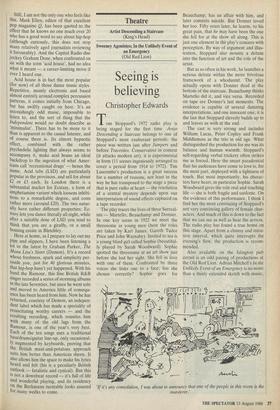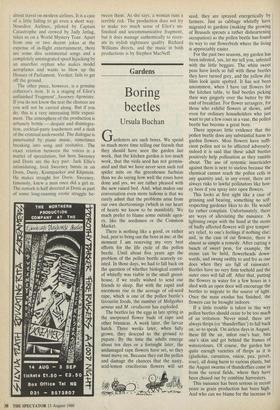Theatre
Artist Descending a Staircase (King's Head) Sweeney Agonistes; In the Unlikely Event of an Emergency (Old Red Lion)
Seeing is believing
Christopher Edwards
Tom Stoppard's 1972 radio play is being staged for the first time. Artist Descending a Staircase belongs to one of Stoppard's most exuberant periods; the piece was written just after Jumpers and before Travesties. Conservative in content (it attacks modern art), it is experimental in form (11 scenes ingeniously arranged to cover a period from 1914 to 1972). Tim Luscombe's production is a great success for a number of reasons, not least in the way he has transposed to the stage a piece that is pure radio at heart — the resolution of a central mystery depends upon our interpretation of sound effects captured on a tape recorder.
The play traces the lives of three Surreal- ists — Martello, Beauchamp and Donner. In one key scene in 1922 we meet the threesome as young men (here the roles are taken by Karl James, Gareth Tudor Price and John Warnaby). Invited to tea is a young blind girl called Sophie (beautiful- ly played by Sarah Woodward). Sophie spotted the threesome at an art show just before she lost her sight. She fell in love with one of them. Confronted by three voices she links one to a face; has she chosen correctly? Sophie goes for
Beauchamp, has an affair with him, and later commits suicide. But Donner loved her too. Fifty years later, he learns, to his great pain, that he may have been the one she fell for at the show all along. This is just one element in the play's concern with perception. By way of argument and illus- tration, Stoppard also mounts a debate into the function of art and the role of the artist.
But as so often in his work, he launches a serious debate within the more frivolous framework of a whodunnit. The play actually opens with Donner dead at the bottom of the staircase. Beauchamp thinks Martello did it, and vice versa. Recorded on tape are Donner's last moments. The evidence is capable of several damning interpretations, and one innocent one; it is the last that Stoppard cleverly builds up to and leaves us with at the end.
The cast is very strong and includes William Lucas, Peter Copley and Frank Middlemass as the trio in old age. What distinguished the production for me was its balance and human warmth. Stoppard's self-regarding verbal trickery often strikes me as forced. Here the smart paradoxical flair his audiences have come to love is, for the most part, deployed with a lightness of touch. But most importantly, his charac- ters have heart, in particular Sophie. Sarah Woodward gives the role real and touching life — she is both fragile and sardonic. On the evidence of this performance, I think I find her the most convincing of Stoppard's not very convincing gallery of female char- acters. And much of this is down to the fact that we can see as well as hear the actress. The radio play has found a true home on this stage. Apart from a clumsy and intru- sive interval, which quite interrupts the evening's flow, the production is recom- mended.
Also available on the Islington pub circuit is an odd pairing of productions at the Old Red Lion. Adrian Mitchell's In the Unlikely Event of an Emergency is no more than a thinly extended sketch with music, 'If it's any consolation, I was about to announce that one of the people in this room is the murderer.' about travel on modern airlines. It is a case of a little failing to go even a short way. Nosedive Airlines, piloted by Captain Catastrophe and crewed by Judy Jetlag, takes us on a World Mystery Tour. Apart from one or two decent jokes at the expense of in-flight entertainment, there are some dire sentimental songs and a completely unintegrated spoof hijacking by an anarchist orphan who makes model aeroplanes and wants to blow up the Houses of Parliament. Verdict: fails to get off the ground.
The other piece, however, is a genuine collector's item. It is a staging of Eliot's unfinished 'Fragment', Sweeney Agonistes. If you do not know the text the chances are you will not be carried along. But if you do, this is a very interesting little experi- ment. The atmosphere of the production is urbanely brittle — despair and disintegra- tion, cocktail-party loucheness and a dash of the criminal underworld. The dialogue is punctuated by piano music, sometimes breaking into song and recitative. The exact relation between the voices is a matter of speculation, but here Sweeney and Doris are the key pair. Jack Ellis's intimidating, livid Sweeney bursts in on Doris, Dusty, Krumpacker and Klipstein. He makes straight for Doris. Sweeney, famously, knew a man once did a girl in. The remark is half directed at Doris as part of some long-running erotic struggle be- tween them. As she says, a woman runs a terrible risk. The production does not try to make too much sense of Eliot's un- finished and uncommunicative fragment, but it does manage authentically to recre- ate its stylish nightmare quality. Richard Williams directs, and the music in both productions is by Stephen MacNeff.























































 Previous page
Previous page